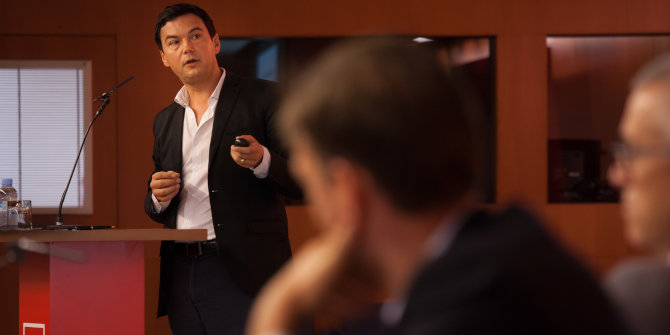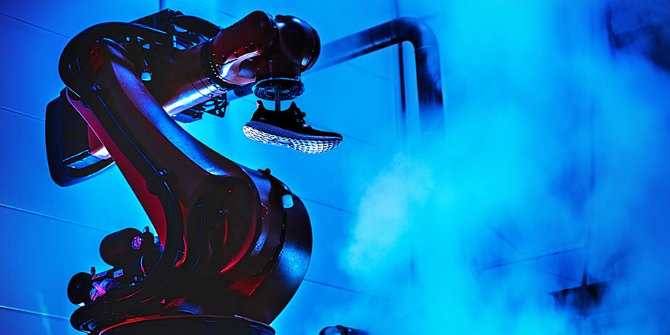 In a section of his latest book, Thomas Piketty attempts to chart how political competition has evolved in contemporary societies. Jan Rovny writes that although many of Piketty’s conclusions are not entirely original, they touch on important shifts that have taken place in recent decades. Among the most important is the reversing role of education in political alignment: while highly educated voters once backed parties on the right, they are now far more likely to support those on the left.
In a section of his latest book, Thomas Piketty attempts to chart how political competition has evolved in contemporary societies. Jan Rovny writes that although many of Piketty’s conclusions are not entirely original, they touch on important shifts that have taken place in recent decades. Among the most important is the reversing role of education in political alignment: while highly educated voters once backed parties on the right, they are now far more likely to support those on the left.
In his recently published work, Thomas Piketty addresses the changing structure of political conflict in contemporary societies, particularly focusing on the changing electoral effects of education and income. His empirical account, based on extensive time-series data from individual level surveys leads him to four fundamental findings. First, that there has been a decline in class voting. Second, that in terms of income voting, the wealthy vote for right-wing parties – what Piketty calls the ‘Merchant right’. Third, that educational voting has inverted over the post-war period. While earlier the educated voted for the right, in recent years they have voted for the left – constituting what Piketty refers to as the ‘Brahmin left’. Finally, this leads to the creation of a new cleavage of globalists versus nativists.
As a political scientist, I find this research fundamentally substantively important, and empirically enriching – particularly through the use of long-term temporal data. In many ways, these findings have been the bread and butter of political science research for a number of decades. The decline in class voting was highlighted by David Butler and Donald Stokes as early as in the 1970s, and by many others since. The right-wing allegiance of the wealthy is as universal as it is uncontroversial. The transformations of the left that Piketty identifies have been analysed by Herbert Kitschelt in his 1994 study, and by many others afterwards. The argument that a new cleavage has been created goes back to the early work of Ronald Inglehart, and has been thoroughly developed by Hanspeter Kreisi and colleagues, Herbet Kitschelt, as well as Gary Marks and Liesbet Hooghe, only with different names.
 Thomas Piketty, Credit: Universitat Pompeu Fabra (CC BY-NC-ND 2.0)
Thomas Piketty, Credit: Universitat Pompeu Fabra (CC BY-NC-ND 2.0)
The most striking point proposed by Piketty is his argument about the important and reversing role of education in political alignment. The impressive data which Piketty harnesses demonstrate very convincingly that while the left used to be the political arm of the under-educated, it has become the domain of the educated. This, however, has less to do with the strategies of the left. I will argue that it is mostly due to deep structural changes in modern societies which reconstituted different social classes and their political interests.
Education in Piketty’s account is a proxy for the changing nature of work and production towards the end of the 20th century. This change is associated with an important value shift in a significant section of the population, redefining political preferences and inducing change in the political supply. Fundamentally, this great transformation is fuelled by structural changes in the economy – the rise of modern technologies, increased trade, and the expansion of the education system. To answer Piketty’s concluding question, the educational shift precedes and is thus independent of mass migration, which became politically significant only from the mid-1980s onwards.
Why has the relationship between education and the left vote flipped? There are two sides of the education coin. First, the higher educated have become far more diverse than they used to be. In the 1950s and 60s, the higher educated were a relatively narrow group of professionals – doctors, lawyers, professors, engineers – generally assured secure and well rewarded employment. By the 2000s, the highly educated greatly increased their population share, and span a wide spectrum of business professionals, technical professionals, and intellectual professionals. While they share high levels of education and training, they differ widely in the types of tasks they perform, as well as in their employment outlooks, as many university graduates search for work in vain.
The work of Daniel Oesch demonstrates the importance of different ‘work logics’ which influence the formation of political preferences and electoral affinities. It is thus particularly socio-cultural professionals (professors, teachers, journalists), engaging in interpersonal contact, who tend to support culturally progressive and economically left-wing parties, while business and technical professionals tend to be slightly less culturally progressive and economically right-wing. This effectively splits the highly educated into what Piketty calls the ‘Brahmins’ and the ‘Merchants.’
The second side of the education coin is the low-educated working class. This segment of the population has been the traditional bastion of left-wing support, but its structural transformation has been even more dramatic than that of the higher educated. The traditional industrial working class has almost disappeared from developed societies. It has been made redundant through the exodus of industrial production to less-developed countries, it has been displaced by machines, robots and computers, and to its socio-political position came large swathes of lower grade service workers – the restaurant staff, the drivers, the cleaners. They are today the ‘working class’ of developed societies.
But these people, dispersed in their daily tasks carried out in isolation from one another, do not share the collective identity and the organisation potential historically present on the factory floor. Atomised, these workers of today have no historical affinity with, nor current ability to mobilise in any significant political organisation or party. The structurally driven disappearance of the industrial working class led left parties to ensure their survival by turning towards the progressive socio-cultural professionals. Silja Häusermann has demonstrated how over the course of the last few decades, social democratic and labour parties have become the parties of the educated, (public sector) white collar middle-classes.
This points to the conclusion implied by Piketty, namely the left’s abandonment of the working classes through its shift towards culturally, rather than economically, progressive politics. It is partly true. But it would be an error to suggest that the left has become progressive and Brahmin only in recent years. As Seymour Martin Lipset suggested, the left’s historical role has always been the cultural emancipation of the working class.
The old industrial working class was never inherently culturally progressive, but its left-wing parties, steeped in the internationalism of Marxist ideology and led by educated ‘Brahmin’ elites, such as Jean Jaurès or Léon Blum, translated working class authoritarian tendencies into a fight for universalistic social progress. They replaced nationalistic tendencies of the working classes with socialist internationalism. The great structural transformation, reflected in the educational flip, resulted in the severing of the ties between the working classes and the parties of the left, leaving these populations in political drift, free to descend towards cultural particularism.
The severing of this connection is as much due to the strategies of the parties (their turn towards the educated socio-cultural professionals), as to the fundamental social reconstitution of the ‘working class’. Today, left-wing cultural conservatives, overwhelmingly made up of the new service underclasses, and other downgraded or under-skilled middle classes are indeed politically lonely. Both because almost no one reaches out to them, and because they have no socio-historical affinities with any political family and no mobilisation capacity of their own.
Piketty calls for the return of this fundamental political connection between the liberalising left and the (innately culturally conservative) working class, but this is increasingly difficult for two reasons. First, the left (or anyone else) cannot simultaneously satisfy the economic and cultural interests of the educated socio-cultural professionals benefiting from the globalised transnationalism of our age, as well as the same interests of the new working class created and threatened by it. Second, the left-wing cultural conservatives of the new working class are effectively courted by the populist radical right, which increasingly proposes to satisfy both their cultural conservatism, as well as their economic protectionism. Radical right parties have made significant inroads in this population segment to the point that they are its main political representatives today.
The only clearly effective association between these populations and progressive political forces (of the left) is, interestingly, ethnic minority status. Among the new working class, it is ethnic minorities who by virtue of seeking to secure their elementary rights from the potential menace of the majority population dominantly support culturally progressive forces.
Please read our comments policy before commenting.
Note: This article gives the views of the author, not the position of EUROPP – European Politics and Policy or the London School of Economics.
_________________________________
 Jan Rovny – Sciences Po, Paris
Jan Rovny – Sciences Po, Paris
Jan Rovny is an Associate Professor at Sciences Po.






This is very perceptive. Thank you. Where I differ is that I think you flip too easily between pollster and Marxist understanding/use of class.
I think too that you are ignoring the depth, nature and sheer numbers involved in the divide that now characterises our age.
This might be of interest: https://colummccaffery.wordpress.com/2019/09/04/surrendering-reality-to-the-ememies-of-democracy-the-left-opt-out/
“The left’s historical role has always been the cultural emancipation of the working class.”
That’s incorrect. The left’s historical role has always been economic emancipation of the working class from the exploitation of their labour by the capitalist class, hence the base/superstructure distinction. It’s only the Gramsci/1968/postmodernist intellectual left that emphasise “cultural emancipation” with some sort of long march through the institutions. But this isn’t the largest faction of the left. Large enough to split it down the middle in the postmodern era, sure, but neither its largest faction nor its “historical role”.
The left’s historical position has always therefore been some version of “socialism”, intended as an economic system different from the capitalist system, centred on investment in and anti-privatisation of public services and trade union support for workers. By contrast, the left’s contemporary position, in their post-1991 acceptance of high capitalism, has thus shifted from its historical position of socialism or social democracy, towards a position of “liberal progressivism” – which seems to involve an awful lot of moralising about cultural issues, the self-righteous language of which tends to patronise most of the traditional working classes. The real question is, will the left move away from its post-1991 “liberalism” and return to “socialist” historical role?
One very important factor, contributing to “the educated” shifting to the political left, was not mentioned in this article:
As the higher education establishments got taken over by the Cultural Marxists, those establishments have become “leftist indoctrination institutions”. In other words, “a highly educated person” has become virtually synonymous with “a highly indoctrinated person”, esp. in the socio-cultural sub-group.